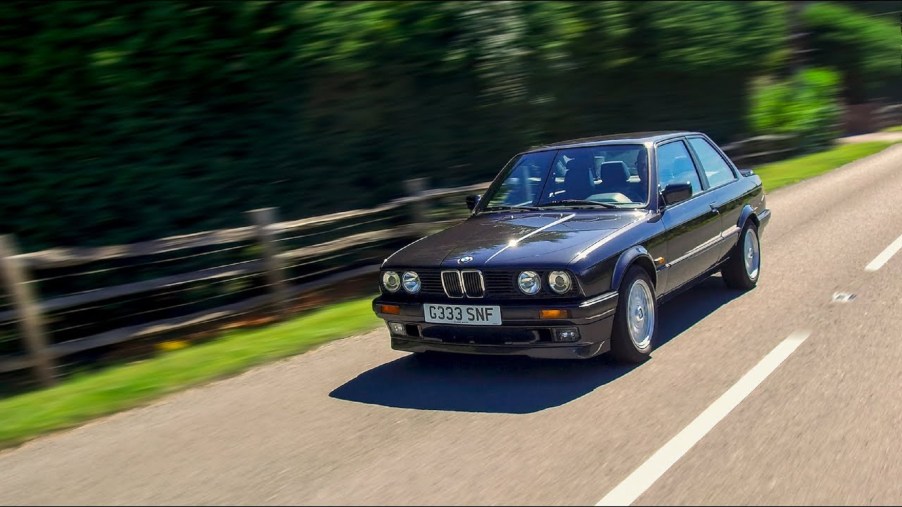
The BMW 320is Was the Italian ‘Tax Special’ E30 M3
Even today, the E30 M3 holds a special place in BMW fans’ hearts and the hearts of car fans in general. But, as is the case today, not everyone could afford it, and it wasn’t always the best choice for commuting. However, as with the 330i ZHP, there was a way to get some of the E30 M3’s special sauce at a discount. At least, there was a way for Italian and Portuguese drivers: the BMW 320is.
The 1988-1990 BMW 320is was the ‘Italian E30 M3’

BMW sold the E30 3 Series from 1982 until 1994, Hagerty reports, split into two ‘generations’: 1982-1987 and 1988-1994. The E30 M3, with its ‘S14’ 2.3-liter four-cylinder engine, arrived for the 1987 model year.
At the time, Portuguese and Italian regulations meant cars with engines larger than 2 liters faced heavy taxes, Petrolicious explains. So, to skirt these regulations, BMW created the 320is. Hence why it’s sometimes called the ‘Italian E30 M3,’ Top Gear explains.

While it doesn’t have an M badge, the BMW 320is shares more than a few mechanical parts with the E30 M3. For example, its engine.
The 320is also has the S14 four-cylinder engine, albeit a 1.99-liter version. But with 192 hp, it’s only down 3 hp compared to the M3, Road & Track reports, though torque is down from 170 to 155 lb-ft. However, it’s linked to the E30 M3’s 5-speed manual, R&T reports. Plus, the 320is has the M3’s gauges and limited-slip differential, albeit with a modified final drive ratio, RM Sotheby’s reports.

The BMW 320is doesn’t have the E30 M3’s suspension or braking hardware. However, it does have the larger brakes from the six-cylinder E30 3 Series, and standard ABS, BMWMRegistry reports. And while it doesn’t have the M3’s fender flares, it does have a standard M Technic II body kit with double-decker spoiler, Petrolicious reports. Plus, the 2-door 320is came standard with upgraded suspension and anti-roll bars. These mods became standard on 4-door cars after September 1989.
Does the E30 BMW 320is drive like the contemporary M3?
Naturally, the BMW 320is isn’t as sharp or as focused as the M3. But it has its own appeal.
R&T reports that the 320is actually understeers less and turns in sharper than the M3. That might be because, while the BMW 320is isn’t as extreme, it weighs 242 pounds less than the M3, Bring a Trailer reports. The shifter’s action isn’t quite as aggressive, but the brakes are “more than sufficient,” R&T reports. And while the chassis setup is “gentler” than the E30 M3’s setup, it’s still a fun car to drive. It also arguably sounds better, R&T reports, and has a higher redline.
More to the point, the BMW 320is is a more comfortable car to drive day-to-day. It has “plush leather seats,” Top Gear reports, a leather steering wheel, and excellent damping. Plus, it was available with A/C, power windows, and an early digital display. And like all E30 3 Series, it’s “one of the easiest modern classics to own and drive,” Hagerty reports.
It was a bargain then, and it’s still a relative bargain now
As we stated earlier, the BMW 320is exists because of taxes. And, not only was it made as a kind of bargain E30 M3, the 320is still a more affordable alternative. That’s despite being rarer than the M3, R&T reports.

E30 M3 values have risen dramatically over the years. Today the average example sells for around $50,000 on BaT. A pristine one can easily sell for two or three times that, Hagerty reports. In contrast, the 320is is closer to the $15,000-$30,000 range, BaT reports. In July 2020, a 1988 example sold for the equivalent of $29,900 at an RM Sotheby’s auction.
Follow more updates from MotorBiscuit on our Facebook page.


